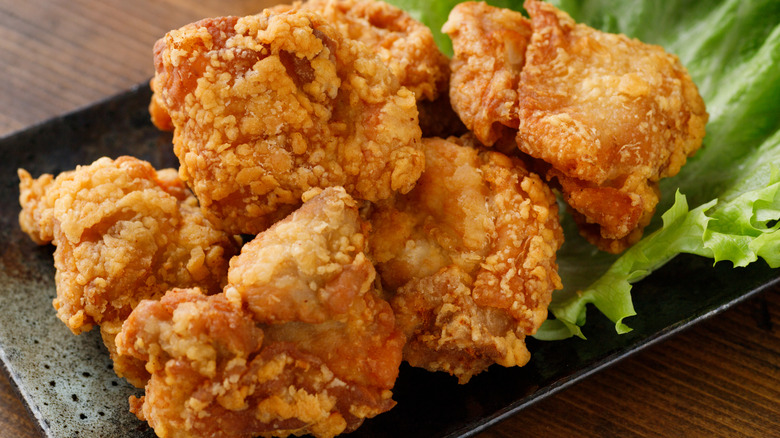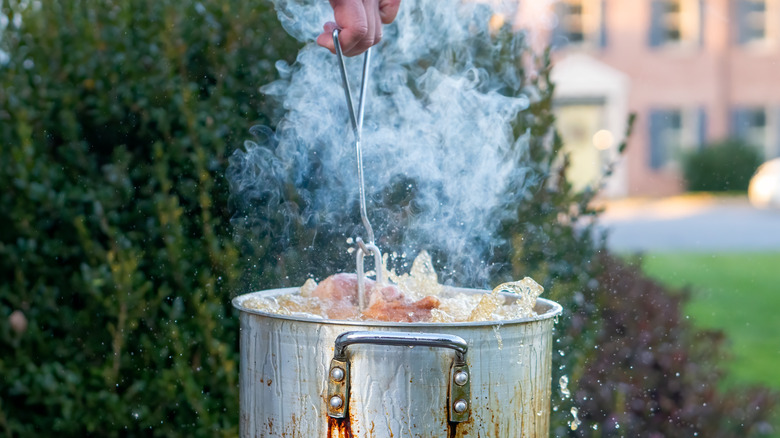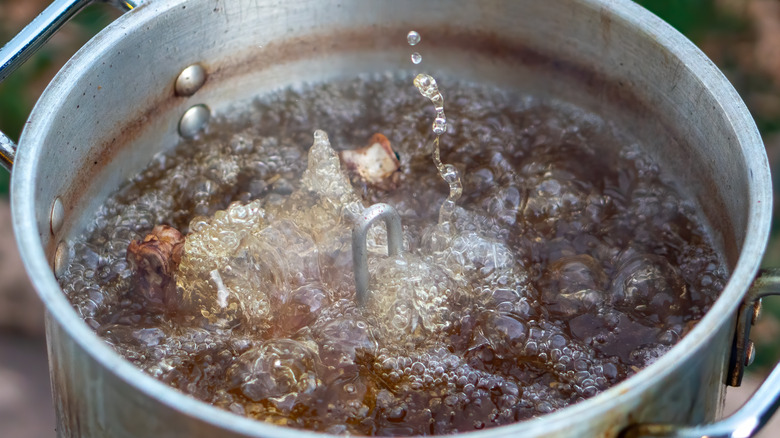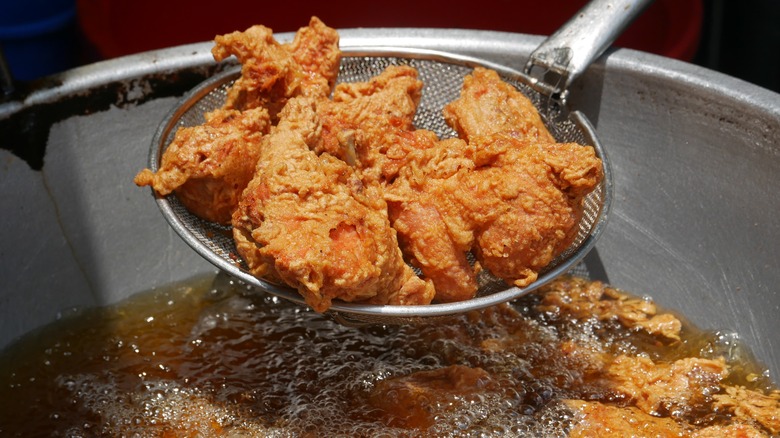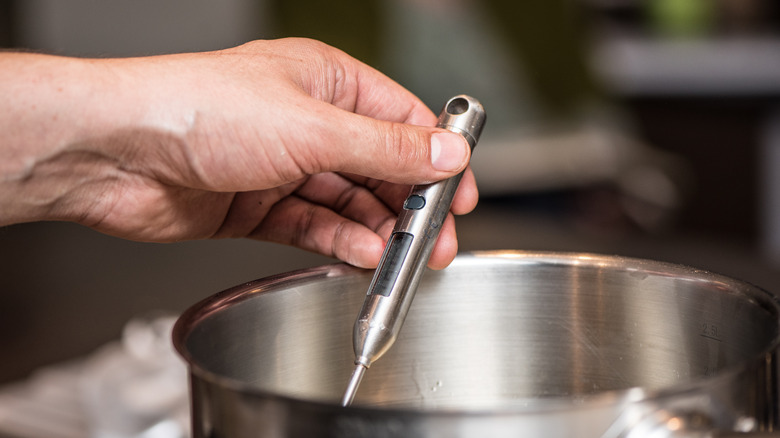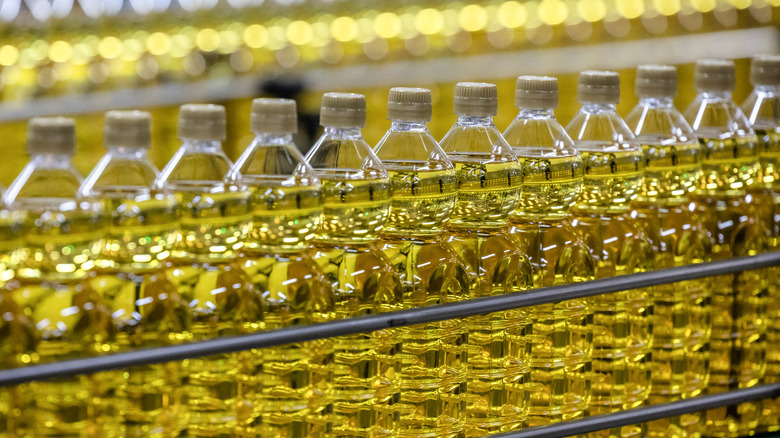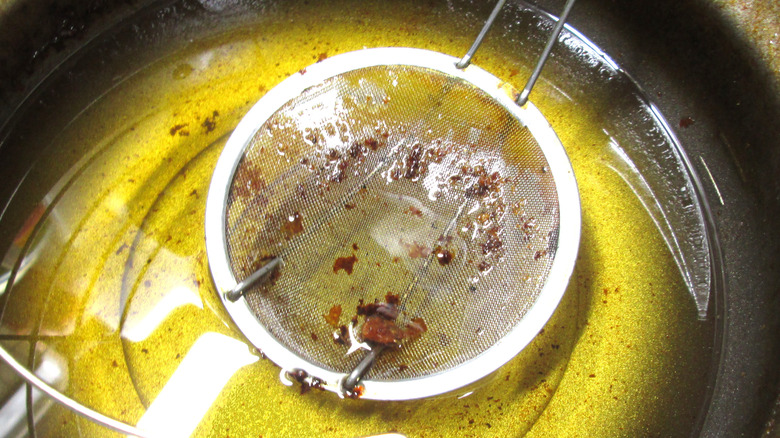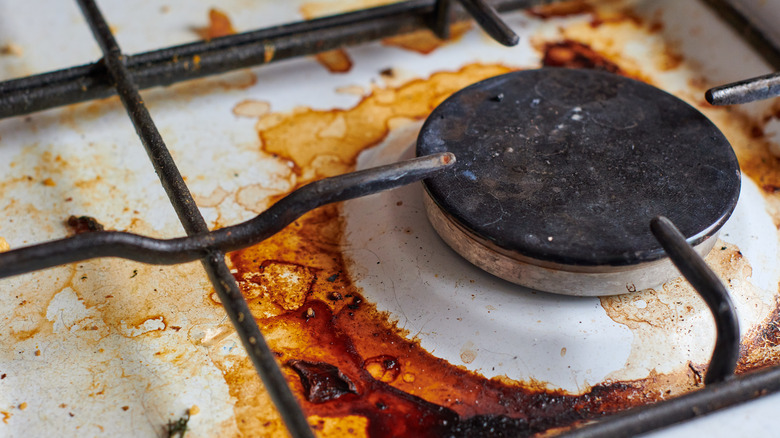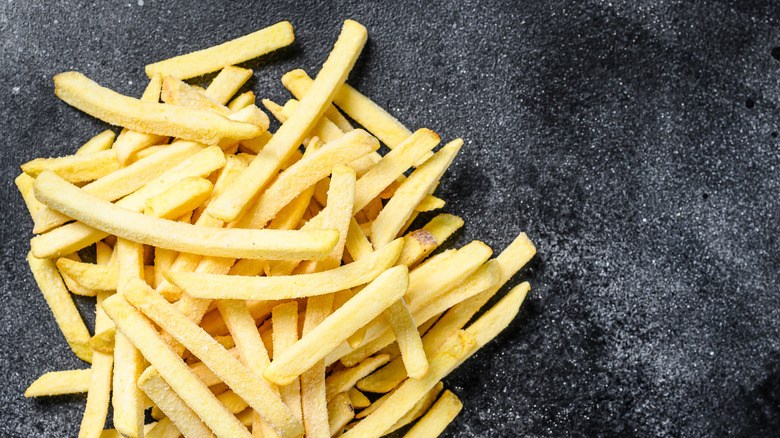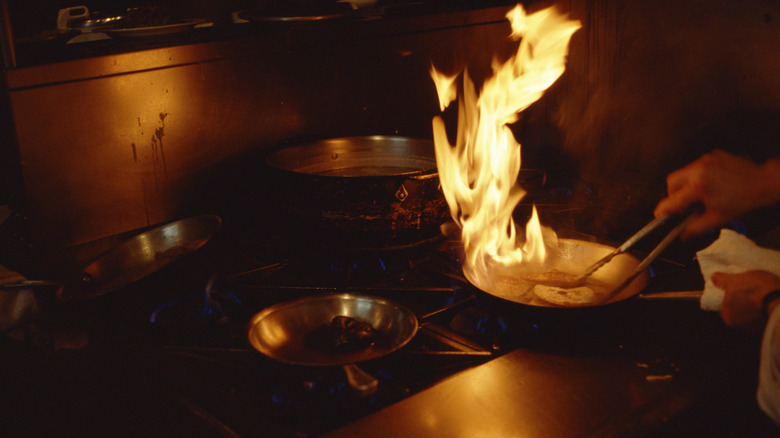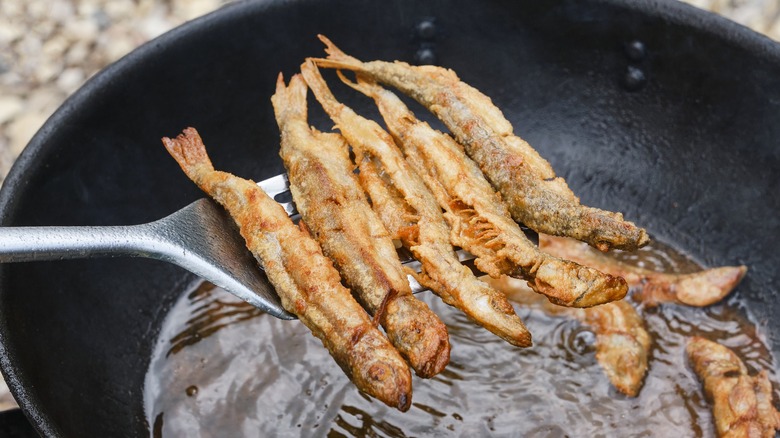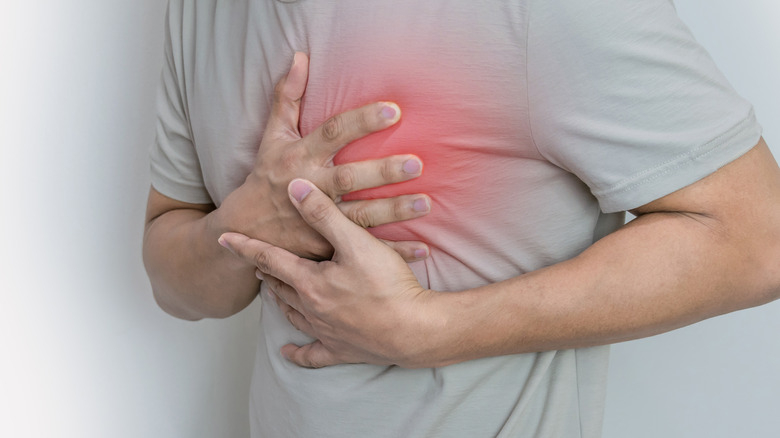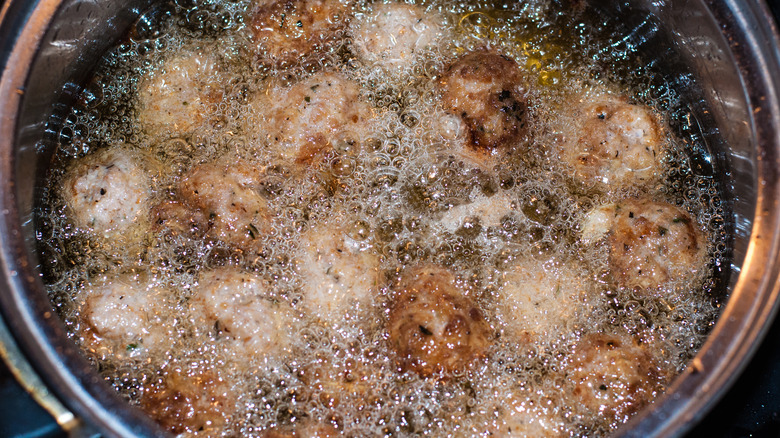Why You Should Absolutely Never Deep Fry At Home
French fries, onion rings, and battered fish may be bar food favorites, but they don't really have a place in your home kitchen. Hear us out. It's not that you can't deep fry at home. After all, the Internet is awash with guides to deep frying and recipes purporting to give you all the tips and tricks you need for success. But just because you can do it doesn't mean you should. Indeed, there are loads of reasons why deep frying at home is a bad idea.
Let's start things off with the sheer amount of stuff you need to deep fry at home, from massive pots to large quantities of oil. Then there's the mess of an operation that's hands-on at best and bordering on dangerous at worst. And of course, it's no secret that cooking in so much oil has certain health risks that can't be ignored. Let's face it: Even if you do manage to successfully amass the stuff you need to deep fry at home — and pull it off — the resulting deep-fried morsels, as crispy and crunchy as they might be, can hardly be considered health food.
Still need convincing? Here are all of the reasons deep-fried food should remain strictly in a restaurant kitchen.
Deep frying makes your kitchen smell bad
It's one thing to walk into a dive bar and take in a whiff of cold fries. (Seriously, how does that smell burrow so deeply into the walls?) It's another thing entirely to have the same smell in your kitchen.
Deep frying emits an odor that can infiltrate everything from home furnishing to clothes to our own hair, and not just for a moment or two (via Cookist). According to Southern Living, the smell can linger for 24 hours or longer. (Is it any wonder that people who can move the operation outside choose to do so?)
Cookist offers a number of methods to reduce or offset the smell of deep frying at home, including boiling water and vinegar (which one can only imagine simply replaces the smell of fried food with the smell of vinegar). And while there are some brands of deep fryer that purport to reduce smelliness, as KitchenCuddle explains, the reality is that once you start frying, your house is going to smell like the inside of a fryer... at least for a while.
You need a really big pot to deep fry at home
While home deep fryers do exist, these tabletop appliances tend to be bulky. Indeed, in its ranking of some of the best home models out there, Epicurious noted that its all-time fave model takes up "a good amount of storage space" on your countertop. Even compact models might be a luxury for those living in close quarters.
It's for this reason that most people rely on a pot or Dutch oven instead, but even this invites no small amount of bulk to the party. CNET recommends a pot or pan that's five inches deep at minimum, noting that a two-gallon pot is really ideal. This, according to YouTuber Adam Ragusea, is due to the fact that not only does deep frying require a significant amount of oil, but you also need to leave space for the displacement of that oil once the food to be fried is added, not to mention any bubbling or spitting that could lead to dangerous repercussions.
The long and short of it? Deep frying for most home cooks means lugging out the big, bulky, expensive cast iron Dutch oven every time you want to cook even a small batch of fried food — and leaving it out until the oil has completely cooled.
Deep frying is a very hands-on enterprise
Unlike roasting, grilling, or even air frying, deep frying demands your full and undivided attention, per YouTuber Adam Ragusea, who, in his tirade against deep frying, lingers (and rightly so) on the sheer amount of attention and energy that goes into this cooking method, especially at home.
First off, you need to "mother" the oil temperature, he explains, which has a tendency to plummet due to the relatively small amount of oil being used (versus in an industrial or professional kitchen). Cold food added to hot oil leads to falling temps, and it's up to the cook to work quickly, not just to bring the oil back up to the right heat level, but also to keep close tabs on it for the duration of the cooking process. And since deep frying at home is usually going to be a batch-cooking venture, he adds, you need to keep your eye on the prize for far longer than the cook time of a single serving of fries.
You also need other gadgets to deep fry effectively
In addition to a large Dutch oven or pot, deep frying effectively requires no shortage of cooking equipment. First off, as YouTuber Adam Ragusea states, you need a candy thermometer in order to ensure you're keeping your oil at the proper temperature for the duration of cooking.
To this, CNET adds a veritable shopping list of accessories: a spider for removing cooked food from the oil, a cooling rack on which to place the food fresh out of the fryer, and a cookie sheet to collect all of the oil that drips off of the freshly fried food. You will likely also need wax paper or paper towels to collect or blot the excess oil from the food. And until you've stocked up on all of these accessories, the barrier to entry for deep frying at home is actually relatively high, not to mention pricey.
You need a lot of oil to deep fry at home
Gadgets are not the only thing you'll need to purchase in order to deep fry at home. There is also the question of the oil to contend with, and you'll need a lot — probably way more than you think.
The reason why deep frying requires such a sheer quantity of oil is that the food you're frying needs to be totally submerged in the hot fat in order to fry evenly. According to KitchenSnitches, you're looking at somewhere between nine and 16 cups of oil for a tabletop deep fryer.
If you're going for the cast iron pot method, CNET recommends about four to six cups of oil (which is still a lot of oil), while Louana calls for upwards of two gallons for a batch of fried chicken. Of course, the exact amount will vary according to the recipe and the frying vessel you choose, but either way, you'll need to stock up.
Discarding frying oil is a pain
Given the sheer amount of oil you need to use to deep fry at home, it may be reassuring to learn that you actually can repurpose it. According to KitchenSnitches, as long as you filter oil after each use, you can reuse oil somewhere between four and eight times, depending on the food you're deep frying.
But just because you can doesn't mean you should (or will). First off, the fact that you probably don't want to use the same oil to fry, say, chicken and doughnuts, means that in a home setting, you're either holding onto multiple bottles of used oil or you're discarding between uses, like YouTuber Adam Ragusea does. And discarding frying oil is a pain, whether it's the first time you've used it or the eighth.
ACT Enviro cautions against simply pouring frying oil down the drain, where it can clog up the pipes and "have a cumulative and potentially harmful effect" on the environment. Instead, the outlet recommends waiting until the oil is cooled before carefully pouring it into empty containers like plastic bottles or empty milk cartons and then throwing it away. Not only is this messy and time consuming, but it means that potentially recyclable containers are going directly into the rubbish bin. Not all that environmentally friendly, is it?
Deep frying is messy
From the spatter of frying oil to the transfer to racks, deep frying is a messy endeavor indeed. As YouTuber Adam Ragusea explains, the sputtering oil can easily can dot your cooktop — but also your clothes — with grimy hot oil, which is a pain even if it doesn't burn you. The draining step is no neater: The spider, cookie sheet, and rack CNET recommends you use will also end up covered in oil, as will the ground you cover getting it from point A to point B (countertops and floor), even if you're careful. And then, of course, there's the issue of either storing or discarding the used oil to contend with.
In short, deep frying certainly turns the otherwise just-annoying chore of doing the dishes after dinner into a Herculean effort. And is it really worth it for a plate of what Ragusea contends is often cold fish and chips?
It's hard to keep everything hot when deep frying at home
It would be one thing if you were going to all of this effort to produce a truly extraordinary meal, but as YouTuber Adam Ragusea explains, this is rarely the case when deep frying at home. The problem is one of scale: With an industrial-sized deep fryer, he explains, it's easy to cook the entire portion of fries, for example, in one fell swoop, ensuring that each member of the party gets a serving that's piping hot and crisp. But with the at-home method — and the smaller size of the frying vessel — most of the time, you need to work in batches.
While Ragusea details some of the tips chefs and home cooking outlets suggest to deal with this issue (such as keeping batches warm in the oven while you proceed with the rest of the cooking), the reality is that rarely will everyone at the table get a perfectly crisp, fried fry. In other words, you've gone to all that work and effort for nothing... or if not nothing, at least a sub-par iteration of the food you were craving.
Deep frying can be dangerous
Deep frying isn't just a pain because of the effort involved; it can also be dangerous for home cooks. This should come as no surprise, since you're essentially cooking in what amounts to a medieval technique of warfare. History Extra reports that despite Hollywood taking some liberties with just how frequently this technique was used, there are several accounts of its use, namely during the Hundred Years' War. While it's certainly not the goal, one clumsy nudge and the cooking technique could lead to detrimental effects on the cook or any small children or pets in the vicinity, something YouTuber Adam Ragusea clearly shows in his video as he explains why he keeps his kids far from the hot pot.
Wisconsin's Fitchburg Fire Department notes on its website that deep frying, particularly turkey, can be very dangerous, with a "high risk" of tipping, overheating, or spilling, contributing to the increased risk not only of burns and injuries but also fires. Indeed, the department notes, not only can just a small amount of oil coming into contact with burners cause fires, but "Without thermostat controls, deep fryers have the potential to overheat the oil to the point of combustion."
Shallow frying is not the same thing as deep frying
It bears mentioning that in addition to deep frying, a technique known as shallow-frying is a popular way to achieve a crispy, crunchy crust on your favorite foods. And unlike deep frying, it's far better suited to the home kitchen.
FoodsGuy describes the difference between the two techniques as basically coming down to the amount of oil you use: Whereas with deep frying, the entire food needs to be submerged in hot oil, with shallow frying, only parts are submerged. A smaller quantity of oil means you can use a smaller pot or pan, doing away with some of the issues linked to deep frying, though not all.
The danger of burns still remains a concern, and some would argue that shallow-frying is an even more hands-on endeavor than deep frying, requiring more babysitting and turning of each piece of food as it cooks. And while the quantity of oil is smaller, it still needs to be discarded, which remains just as messy whether you're using a large or small quantity of fat. That said, shallow-frying can be a good way of achieving similar results with less hassle.
Fried food is not good for you
Whether you're deep frying or shallow frying, it should come as news to exactly no one that deep-fried foods are not the pinnacle of all things healthy. It does bear repeating, though, if only because fried foods are bad for you in so many different ways.
Fried foods aren't just higher in calories, according to Healthline, which notes that a hundred grams of fried potatoes contains more than three times the calories of a baked potato of the same weight. Those extra calories come in the form of trans fats, a hydrogenated form of fat that is associated with an increased risk of diabetes, heart disease, and even cancer.
Indeed, according to one study in the medical journal Prostate, consumption of deep-fried foods may contribute to an increased risk of prostate cancer specifically, due to the formation of carcinogenic compounds during the frying process. If you needed yet another reason to opt out of deep frying, your health — and that of your family — is a pretty good one.
Fried food can cause cancer
Trans fats have been linked to a number of negative side effects, according to Healthline. Artificial trans fats may have been banned in the U.S. back in 2014, but trans fats still form when oils are heated beyond a certain temperature, according to Healthline. And while the outlet is quick to note that these trans fats haven't been linked to the same negative side effects as artificial trans fats, they're definitely still not good for you.
One study suggests that trans fat consumption may increase your breast cancer risk. Another study showed an association between trans fats and colorectal cancer. It should be noted that this research is on industrially produced trans fats rather than those made as a byproduct of deep frying, but it's still a cause for concern. For fried food specifically, in addition to the prostate cancer link mentioned above, fried foods have also been shown to possibly increase your risk of gastric cancer, pharyngolaryngeal cancer, and gallbladder cancer, per a study in Frontiers In Nutrition. If you're deep frying food at home every day, you may be setting yourself up for some serious health challenges in the future.
Fried food is bad for your skin
The idea that fried food may contribute to an increased risk of acne certainly makes sense, in theory. Greasy food must contribute to greasy skin ... right? The truth, according to Verywell, is more complicated than that, but it also doesn't let fried food off the hook for zits.
Fried food, the outlet explains, does not directly cause acne, which can be linked to a number of issues including genetics, hormones, and stress. But a poor diet can make acne worse. The culprit, however, isn't the oil but rather the carbohydrates. That said, battered-and-fried food tends to have a higher glycemic index than foods that are just sautéed or roasted, and a study in the American Journal of Clinical Nutrition has shown that this high glycemic load may increase the likelihood that breakouts will occur. To add insult to injury, fried food can also lead to inflammation, which can make acne worse.
So while greasy food doesn't directly cause greasy skin, the relationship between the health of your skin and the healthiness of the foods you consume is real — and giving up fried foods in favor of low-glycemic options is a good idea if you're concerned about breakouts.
